| |
|
Leica M9 Digital Rangefinder Camera - Page 9 Index of Thorsten Overgaard's user review pages on Leica M9, Leica M9-P, Leica M-E, Leica M9 Monochrom, Leica M10, Leica M10-P, Leica M10-D, Leica M10-R, Leica M10 Monohcrom, Leica M11, Leica M 240, Leica M-D 262, Leica M Monochrom 246, Leica SL, Leica SL2, Leica SL2-S, as well as Leica TL2, Leica CL, Leica Q, Leica Q2 and Leica Q2 Monochrom:
"Shooting style of a Leica M9 Photographer"
By: Thorsten Overgaard
London-based photographer Christopher Tribble uses two Leica M9 cameras along with Canon dSLRs to cover corporate events, gorvernment meetings, portraits concerts and theater. In this interview he tell which cameras he uses for what and explains he workflow with the Leica M9
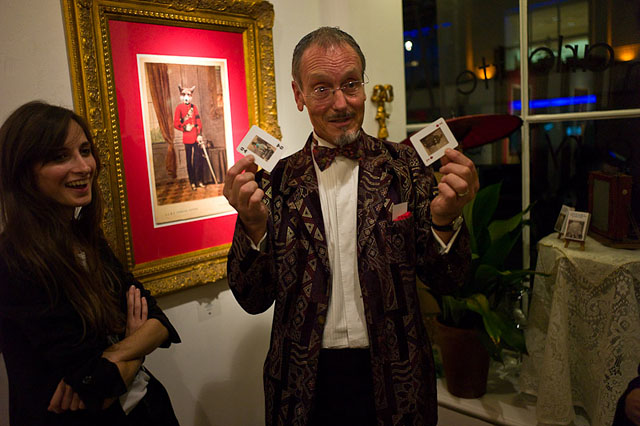
London 2009. Leica M9 with 28mm Summicron-M ASPH f/2.0.
In some ways Chris Tribble is an accidental photographer. His father was a Prison Officer and also the official photographer in Shrewsbury Prison – so he did all the full-face and profile shots of prisoners when they arrived at the jail. He was the one who taught Chris Tribble how to use the ex-Luftwaffe Leica IIIg 35mm and medium format Rolliecord cameras, as well teaching him darkroom technique. By the time Chris Tribble was twelve he could compose acceptable photographs, make contact sheets and decent 10x8" prints. While Chris Tribble has tried not to model his portraiture techniques on his fathers, he did get the key principles on depth of field, focus, and exposure from him.

Tiblisi, Georgia - Secondary School teacher at home. Leica M6 with 35mm SummicronM Mk IV f/2.0 - Nikon Coolscan LS 4000.
When his father died in 1990 he left him the Leica with a 50mm collapsible Elmar. At that time he had started using photography as a part of his work as a programme evaluator in social development projects and wanted a more compact camera with faster lenses than the OM1 system he had been using.
"Although the IIIg was still a functioning camera it wasn't a working tool, so I traded the body and lens in for a used M6 and a 35mm Summicron-M mk IV (a lens he still uses nearly every day), and became a Leica photographer. Over the next couple of years I picked up an early 50mm Summilux-M and a heavy but beautiful 90mm Summicron. The second body, an M6 TTL, came later, and eventually an M7, an 21mm pre-aspherical Elmarit-M f/2.8 and a 135mm Apo-Telyt-M f/3.4.

During this period Chris Tribble had been moving around, living in Latvia, Riga and in Estonia and Lithuania, and then moving to Poland in 1995. In 1998 he moved to Sri Lanka and it was here that he made the shift from darkroom to digital post processing with a series of Nikon scanners (still owns the Nikon Coolscan 4000).
"In Colombo, Sri Lanka I was incredibly lucky to meet two professional photographers who'd also started making the move to digital and I was able to share the pleasure and pain of the transition with them. My first exhibition in Colombo was also the first time in Sri Lanka that digital prints was being presented in a fine art gallery (printed to A3+ on an Epson Photo printer)."
During this period Chris Tribble was building a reputation in documentary photography and was doing more and more work for international development organisations such as Oxfam, GTZ, and DfID as well as the British Council, several of which are still major clients.
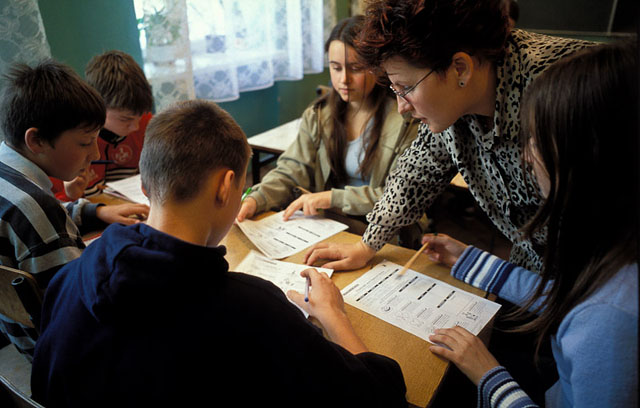
Secondary School, Poland 2003. Leica M6 with 28mm Summicron-M ASPH f/2.0 - Nikon Coolscan LS 4000.
When Chris Tribble moved back to Poland in 2002 he also bought a Canon EOS 1n and a Canon 1v 35mm film cameras with 16-35, 28-70 and 70-200 professional series L zooms (which he still use).
"During this period I also started to get work in theatre / performance photography, cooperating with Teatr Polski in Warsaw on a long term documentation of their productions, as well as collaborating with ECM records. I bought my first digital camera when the Canon 20D came out. The beginning of an expensive – and at times frustrating – climb up another digital learning curve. I found myself using digital capture exclusively. I just didn't have the time to scan the quantity of images that were coming through, and my business wouldn't carry the costs of employing someone else to do the scanning for me. So after the 20D came a 1D mk II, a 5D and now a 5D mk II, and for work with long lenses I still depend on the 5 series Canons."
It felt like coming back home
In 2006 Chris Tribble moved back to London where he is now based but found himself not using his Leicas at all: "I didn't use them at that point, but I couldn't bring myself to sell them, and I didn't want to get rid of the glass. Then came rumours of the M8, and when I learned that it would be a cropped frame sensor I bought a used 28 Summicron-M ASPH f/2.0 in preparation, and as soon as the camera became available in 2006 I bought one. It felt like coming back home. Despite the initial problems with the camera, I was able to return to a style of working which I favoured, and, joy of joys, I was able travel with a small Domke satchel again, rather than having to drag a piece of rolling luggage behind me!"
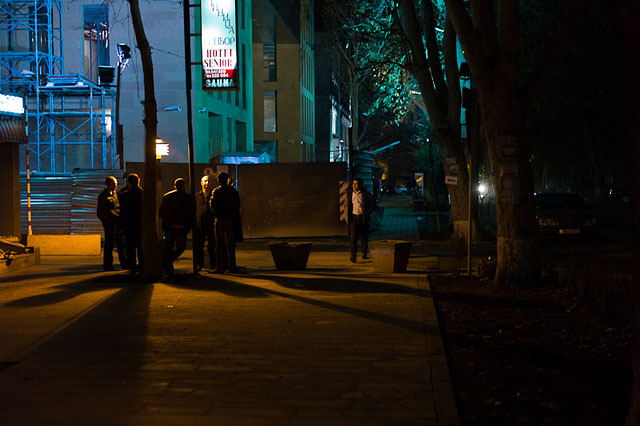
Yerevan, Armenia, 2010. Leica M with 90mm Summicron-M ASPH f/2.0
Leica M9 for the majority of the work
"The M9 has been a logical transition. I now have two M9 bodies, with lenses from 18mm Zeiss through to 135 Apo-Telyt-M and I use this system for the majority of my work. I also keep the Canon 5D and Canon 5D Mark II, mainly using Canon L series 16-35 f2.8, a 85mm f1.2, the 70-200 f2.8 and a 20 year old 300mm f2.8 L USM as these are the essentials for concert and performance photography, as well as for the corporate event work which is emerging as a useful part of the business."
So there Chris Tribble is today. He still work as a university lecturer and do consultancy in the UK and internationally, but photography now takes up around 40% of his time.
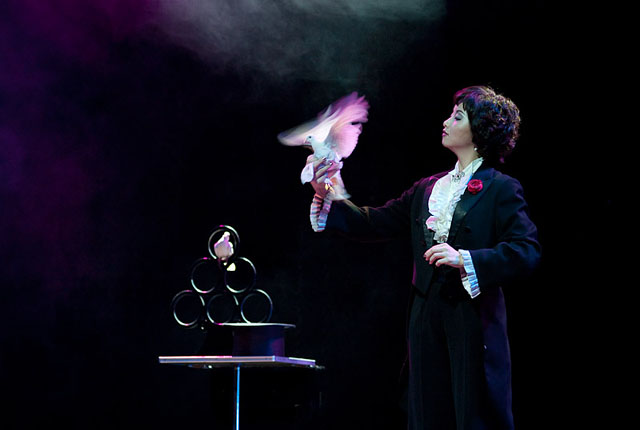
Shanghai, China, 2009. Leica M8 and 135mm Apo-Telyt-M f/3.4.
Do you shoot RAW or JPG?
"I shoot RAW only on all my systems. One of the main reasons for shifting to digital was to get full control of the workflow. This was essential in Sri Lanka where there was only one professional lab capable of processing E6, and it remains important for my business. I need to be able to provide clients with images that they can use for a wide range of purposes from web to billboards. Shooting RAW lets me provide the client with images that are colour correct, in the right colour space, and at the resolutions they need. I couldn't work any other way."
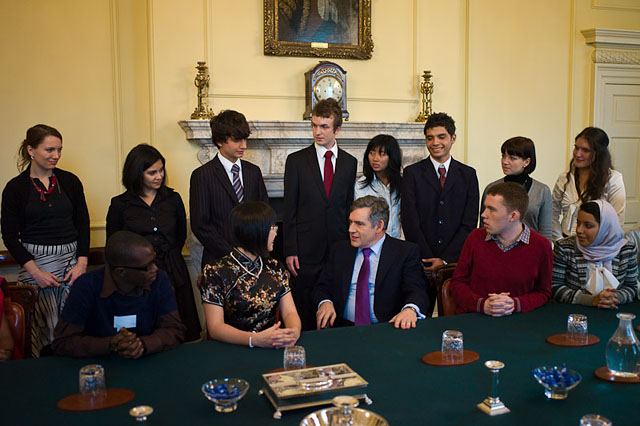
Prime Minister Gordon Brown, London 2010. Leica M9 with 28mm Summicron-M ASPH f/2.0.
What is your ISO and aperture settings on the Leica M9?
"My capture settings vary a bit. On the Leica M9 I reserve uncompressed for ISO 160 and shoot everything else on compressed DNGs. Others might not agree with me on this, but it works very well for me and makes the Leica M9 images easier to manage for archiving and processing. When I walk out of the door I'll typically have the Leica M9 set at 400 ISO and in A mode, with the aperture either fully open or stopped down a little. This means that the camera's ready to go as soon as I see something. For interior shots even in quite low light I rarely need to use more than 800 ISO, but will happily go to 1600 on the Leica M9, something that I wouldn't do on the Leica M8. For bright light I drop to 160, and may use a neutral density filter if it's really bright and I want to keep the aperture open."
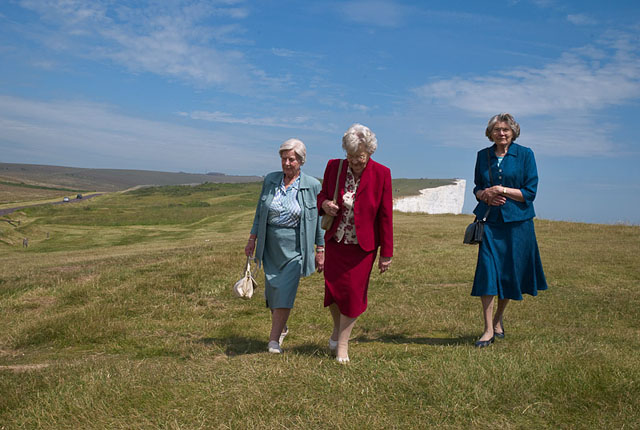
Beachy Head, UK. Leica M8 with 35mm Summicron-M version IV f/2.0
"When I'm working in situations with artificial light I use Manual, always trying to keep the histogram to the right, but not blowing the highlights. Two features I really like about the Leica M9 are the Info button which gives me an immediate view of key parameters (but ISO really needs to be here too, please Leica?), and the Auto Review with Release Button Pressed option. This gives me the freedom to check the histogram and highlights when I need it, without being distracted by previews being generated for every shot. I also like the way I can see the current shutter speed in Info – in low light it can be much easier checking it on the screen than trying to read the shutter speed wheel on the top of the camera. A lot of the time I use Auto White Balance – for most of my work this really does provide an excellent starting point, though I always have a small WhiBal neutral greycard in the bag, which has been a life saver in some circumstances."
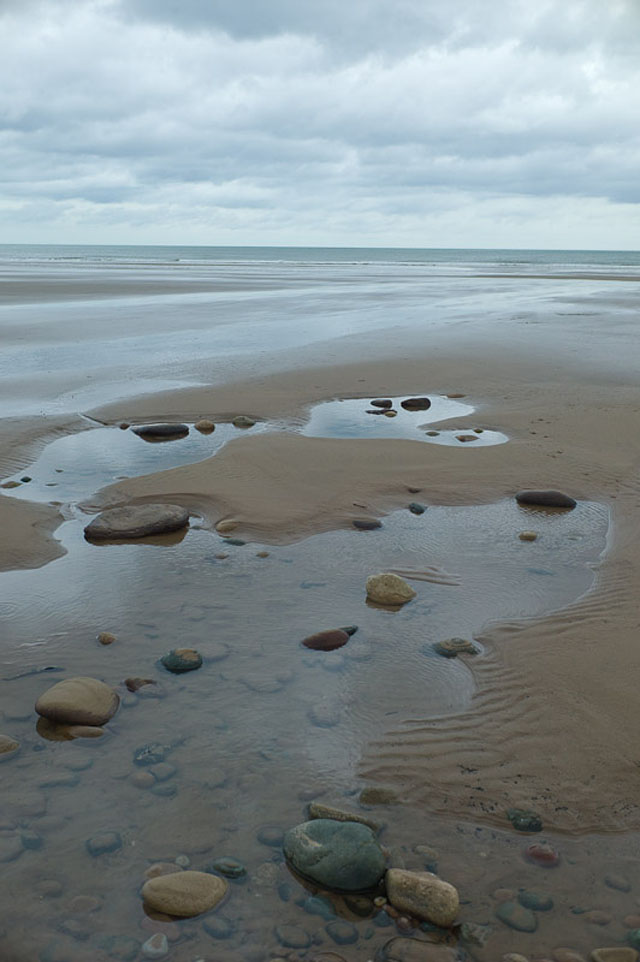
Morecombe, UK, 2010. Leica M9 with 28mm Summicron-M ASPH f/2.0.
What is your workflow software for the Leica M9?
"For post-processing of RAW and image archiving I use Lightroom. In general, I find that this works very well for me, though up until now I've depended on Photoshop CS4 for final sharpening and for printing. I've been looking at the Lightroom 3 beta, and am very optimistic about this. I think that the new RAW processing engine in LR3 is looking very good for M9 images, especially the Noise management and Sharpening modules. And printing for the first time works out of the box for my old Epson Photo 2100 printer."
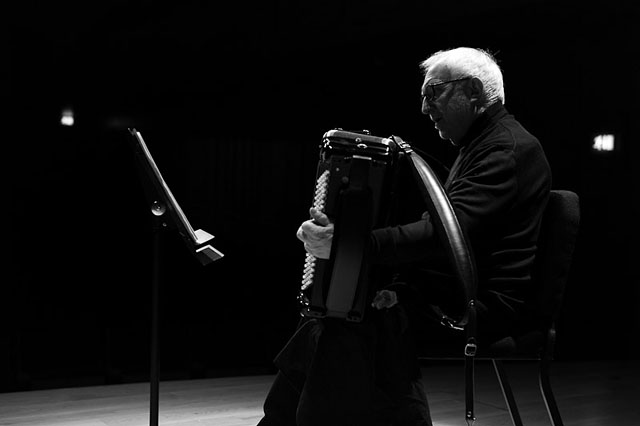
London, King's Place, Gianni Coscia. Leica M9 with 50mm Summiux-M ASPH f/1.4
"Generally I find the control I have in Lightroom is excellent, but I do use some free Black & White plugins developed by David Knoble."
(These can be downloaded from https://outdoorimages.fineart.googlepages.com/DevelopPresetsBnWFilters.zip)
"For Leica M9 image processing in Lightroom I import images with very few adjustments and always set Brightness to 35 and Sharpening to 0. I also follow Jeff Schewe's advice and set Vibrance to 17 and Clarity to 15 in the Presence section on the Develop Module. I like the look this gives."
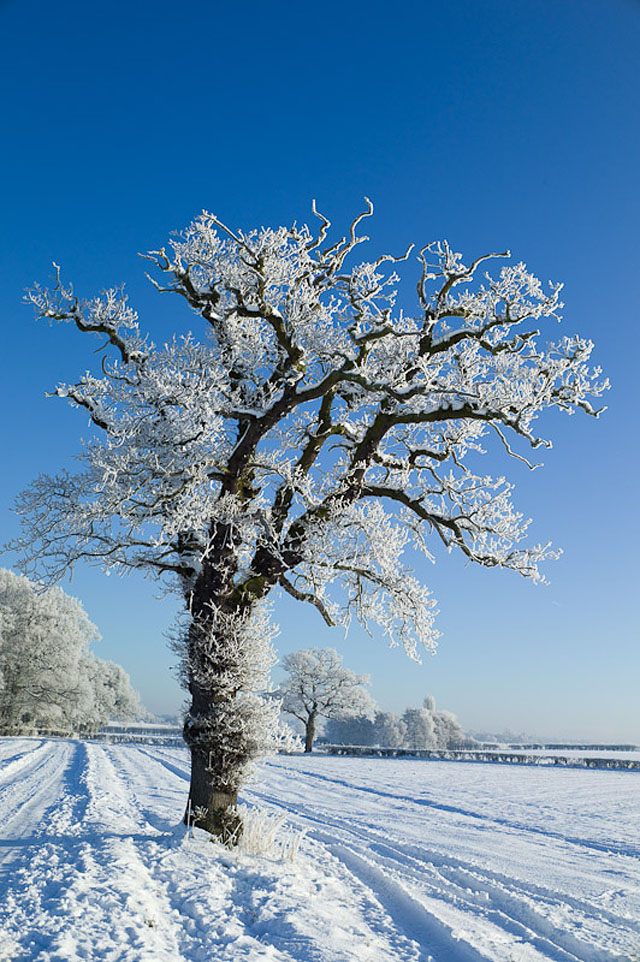
Cheshire, UK 2010. Leica M9 with 35mm Summicron-M version IV f/2.0.
How do you approach a shoot?
"I always work with available light. As an independent free-lancer I don't employ assistants and I'm not able to carry around a separate lighting rig. And frankly it wouldn't suit my style of work. I almost never use flash. I know that many people feel that it is essential to control the light – and when it works it can give a real signature to their pictures, but it doesn't do it for me. I suppose it's a limitation – but I think I've been able to make it a USP [Unique Sales Point] because clients now come to me because they know I don't use lights or flash."
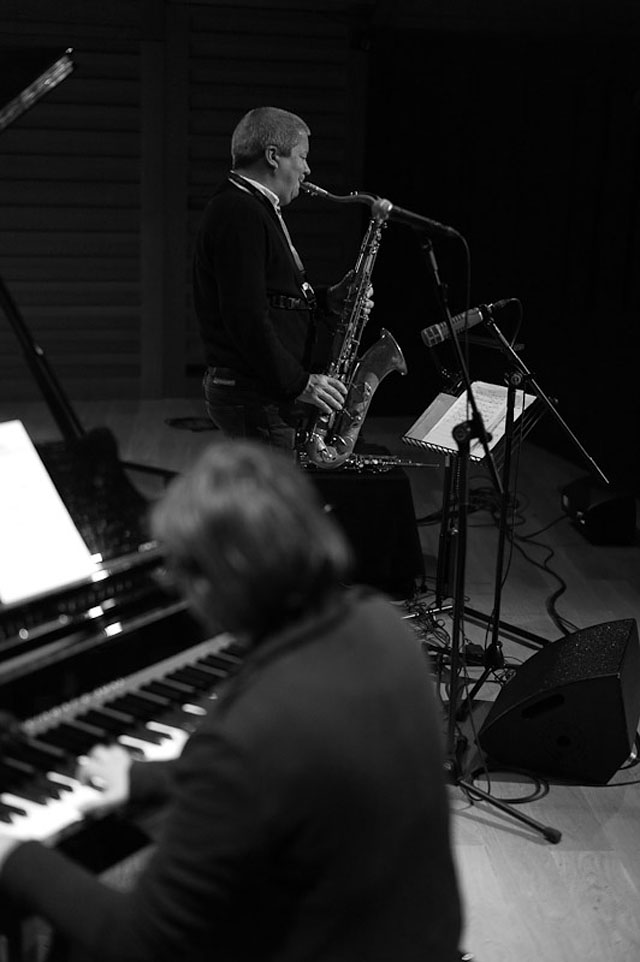
Andy Sheppard, King's Place, London. Leica M9 with 28mm Summicron-M ASPH f/2.0.
"My working approach will vary depending on the job, but there's always one principle that's the same – I have to establish a right to be in the space where I'm working. Whether I'm in a public or private place, the street or a classroom, this usually starts with a period of quietly observing what's going on. This can mean walking through a city, getting a sense of where I am and where I'm going, or it can involve sitting on the floor, leaning against a wall, getting below eye-level, observing what's happening and blending in to the scene. I may then start to work. This can begin from a single vantage point, selecting possible frames, looking at the light and juxtapositions between people and things, people and other people. After a time, it begins to be possible to move about in the space. It's amazing how, after a relatively short time, if you've established a right to be there, you can share a space with those who normally inhabit it. I've found this to be the case in educational settings, theatres, performance spaces, hospitals, wherever. Maybe an example will help:"
"I recently had to do a portrait shoot for the Zehetmair Quartet at the Wigmore Hall. We had an absurdly tight schedule with just 30 minutes available on the stage and no possibility of adjusting the stage lights. Before going to the venue I checked the Quartet's website to get a sense of how they had presented themselves, and as I know ECM's work I had a sense of the image qualities they would be looking for. I made sure that I arrived in good time, met the stage crew – it's always important to have a good relationship with the technical staff – and waited for the group. I'd brought the two Leica M9s and a 28mm Summicron-M ASPH f/2.0 and a 50mm Summilux-M ASPH f/1.4 and a 90mm Summicron-M ASPH f/2.0 as well as a Canon 5D Mark II with f2.8 16-35mm L, f1.2 85mm L and f2.8 70-200mm lenses. I'd also brought a tripod and a monopod – neither of which got used. All of this fitted in the panniers on my bike: As I live in central London I find this is one of the best ways of getting around!"
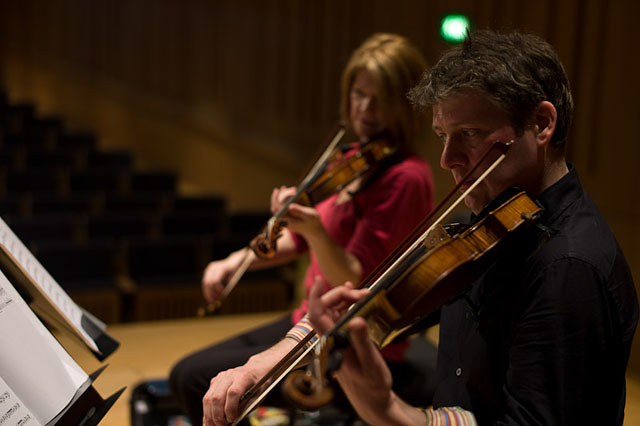
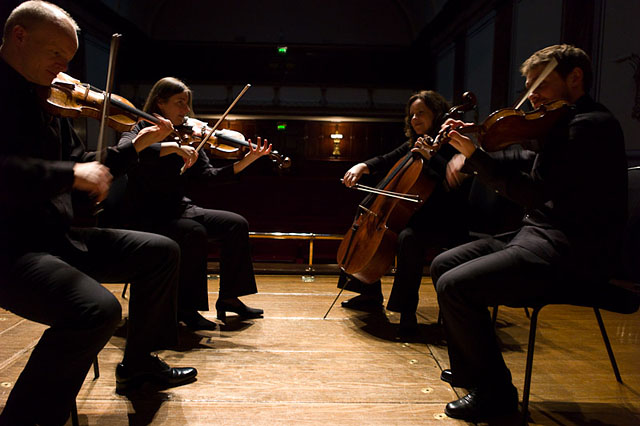
Zehetmair Quartet, Wigmore Hall, London, 2010. Leica M9 wih 28mm Summicron-M ASPH f/2.0.
"As soon as the quartet arrived and we had access to the stage, I got the crew to move a grand piano which was taking up most of the space, explained to the group that I wanted to get them looking as natural as possible. I asked them to sit as they would do normally and play something from the repertoire. It was then a question of walking around, start to work, and then look for the light. I quickly realised that this was dreadful if I looked at the group from the auditorium – and that there was no room to work in. However, if I got them to turn to face the back of the stage and could shoot against the light, we would get some nice lighting. This worked well."
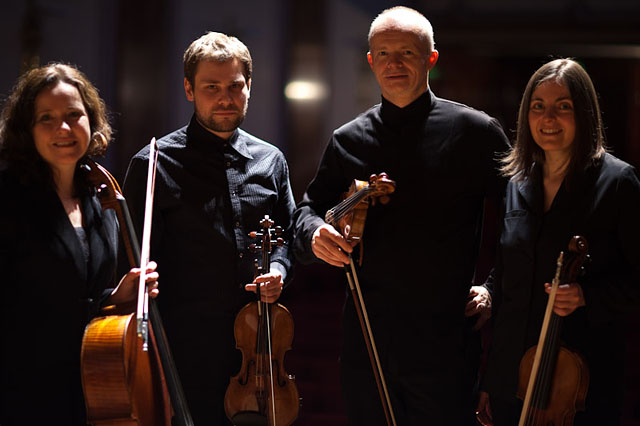
Zehetmair Quartet, Wigmore Hall, London. Canon 5D Mark II with 85mm USM L f/1.2s
"For the more formal portraits, I had by now begun to build a rapport with the players – this is so important – and to explain to them how difficult the light was. We were working well together (I think the fact that I was clearly enjoying the music helped). We were able to experiment with a number of different positions and arrangements of people and to get results which they liked (the faster preview on the M9 helped here when giving them a quick review of what we were getting), and which the designer at the record label has since been really happy with. The essence of the work in this example was to get a sense of the relationships between the people, their concentration and commitment to the work, and also a sense of the location in which they were working (the Wigmore Hall is probably the most prestigious chamber music venue in the UK)."
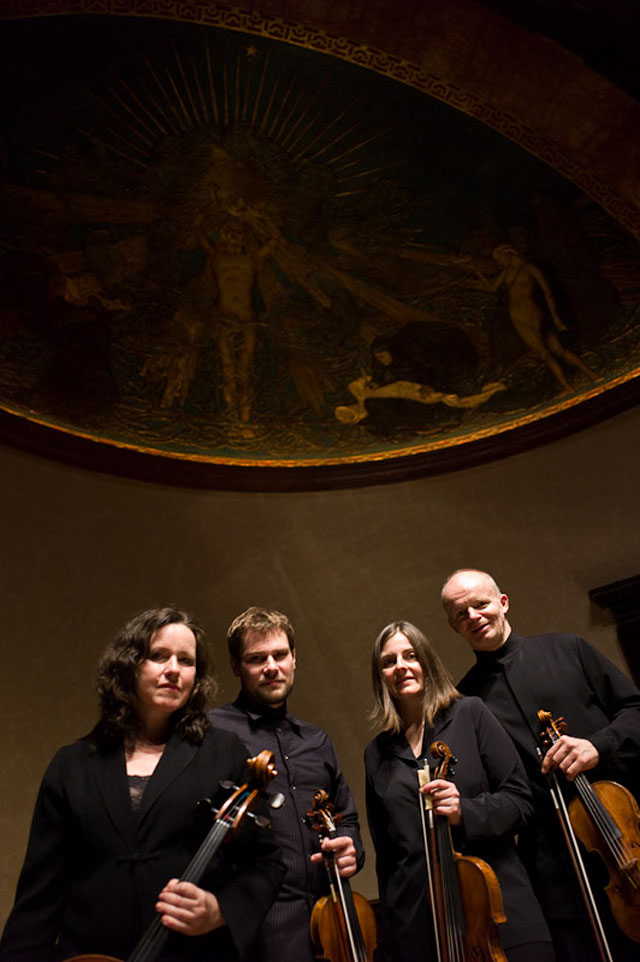
Zehetmair Quartet, Wigmore Hall, London. Leica M9 with 28mm Summicron-M ASPH f/2.0.
"On a recent Corporate job the story was very different. Again, the client didn't want additional lighting to be used, so everything was to be done with available light. No time to visit the venue before the event. This time the task was to make people in a conference setting look like engaged, animated human beings. I was also asked to make sure that I got good shots of all the key speakers. I was using two Leica M9s with 28/35/50/90 and the same Canon 5D Mark II setup as before. I had the monopod but no tripod this time."
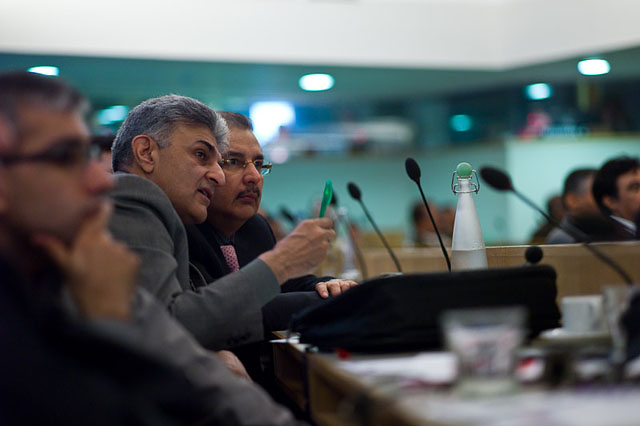
Event, London 2010. Leica M9 with 28mm Summicron-M ASPH f/2.0.
"I was working two rooms, each of which had different light. As I was moving quickly between the spaces, it wasn't feasible to keep on setting a manual White Balance, so I depended on Auto. It was a horribly mix of neon, low-energy bulbs, tungsten spot, data project illumination and daylight, and I found that the Leica M9 did much better than the Canon 5D Mark II. Again, the focus was on concentration, interaction and relationships. I used the coffee breaks to grab moments with face to face interaction going on and used the plenary sessions to find opportunities to frame juxtapositions and different kinds of engagement."
What is your thoughts about the Leica M9 for certain type of assignments?
"For me, the main reason for getting the Leica M9 was to be able to work with lenses in their native field of view. I made the shift from Canon 1D Mark II to the 5D for the same reasons. I don't like cropped sensors. Where does it work the best? Generally, where you can get close to people. For me the 28mm Summicron-M ASPH f/2.0 remains a bread and butter lens. I can pack so much into the image and still not distort the subjects. The 50mm Summilux-M ASPH f/1.4 has also proved to be a marvellous tool for natural perspective shots of individuals and small groups, with the 90mm Summicron-M ASPH f/2.0 coming in both for portrait shots and for images where I want to compress perspective."
"Why do I carry both the Leica 90mm and the Canon f1.2 85mm L? I'm afraid it's because I still find autofocus useful when I'm in a hurry – especially with longer lenses with shallow depths of field. I also do love the way the f1.2 85 draws. It's not necessarily better than the Leica 90mm Summicron-M ASPH f/2.0 – but it's very, very nice."
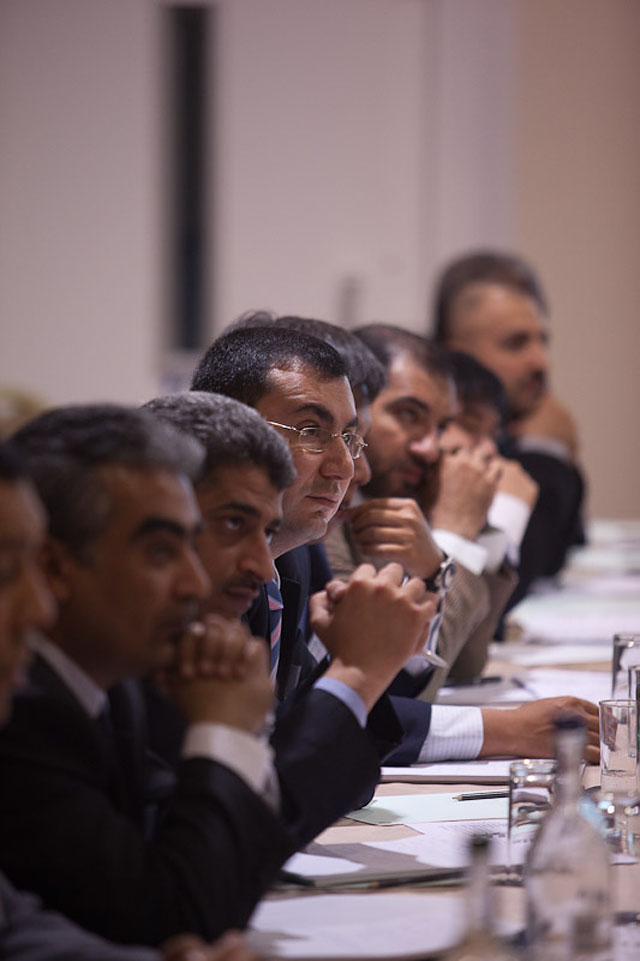
Event, London, 2010. Canon 5D mark II with 70-200mm USM L f/2.8.
"As for the Leica M9 vs. Canon 5D Mark II question ... It's not an either or thing. I suppose that I would never buy a prime wide-angle or 50 mm Canon lens, but I would also never not have a dSLR and some fast long lenses. The interesting borderline comes around 85/90mm, and here I always have a debate about what to put in the bag. I've got a wedding coming up in Poland at Easter, and I'll have to travel light – so I'll take the Leica 90mm Summicron-M ASPH f/2.0. For other jobs I may want the speed of working I get from the autofocus, so then it would be the Canon 85mm f/1.2."

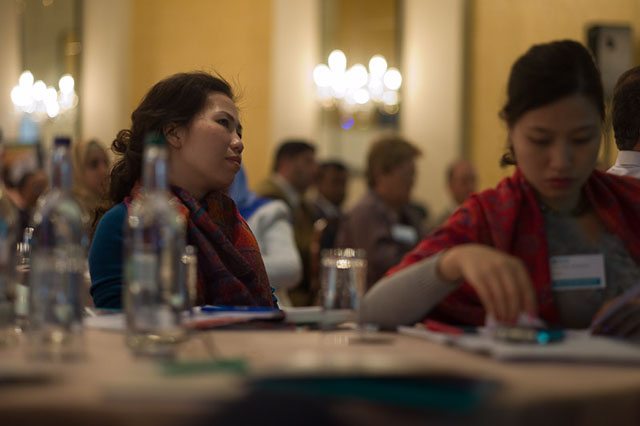
Event, London, 2010. Leica M9 with 90mm Summicron-M ASPH f/2.0.
Which lenses do you use for what, and why?
"As a rule, the default lenses in the bag are 28 / 35 / 50 / 90 along woith two Leica M9 bodies. If I'm trekking and shooting for pleasure with some possible landscape work, I often carry just one body and the 28 and the 135mm Apo-Telyt. For street and documentary work the 35 on one body can cover a whole shoot."
How do you shoot?
"I have to admit that most of the time I like to work with the lenses wide open – stopped down a couple of clicks if I'm using a longer lens and in a hurry, but with Leica lenses, fully open is often so beautiful that it's a temptation to work that way most of the time."
What's the most common thing people ask you about the M?
"Is that a professional camera?"
www.ctribble.co.uk
Index of Thorsten Overgaard's user review pages on Leica M9, Leica M9-P, Leica M-E, Leica M9 Monochrom, Leica M10, Leica M10-P, Leica M10-D, Leica M10-R, Leica M10 Monohcrom, Leica M11, Leica M 240, Leica M-D 262, Leica M Monochrom 246, Leica SL, Leica SL2, Leica SL2-S, as well as Leica TL2, Leica CL, Leica Q, Leica Q2 and Leica Q2 Monochrom:
|
![]()
